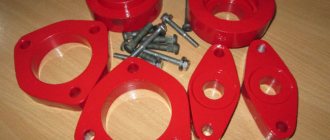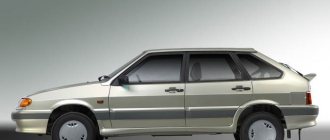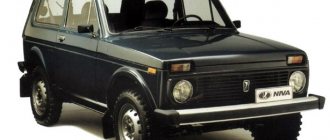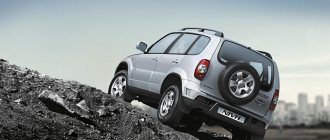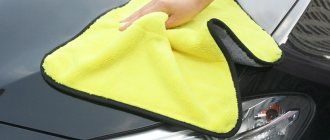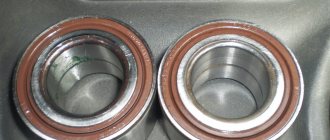Material characteristics
This model is a cylinder shape that is mounted under shock absorbers and suspension springs. Different materials of manufacture, density and dimensions of spacers for increasing ground clearance are determined by the purpose of installation on the front or rear of the car body. As a rule, the choice of one spacer or another does not depend on the make of the car: most parts are universal.
The material used to make parts can be divided into metal (steel or aluminum) and non-metal (polyurethane, plastic). Metal spacers are mounted under the spring, and non-metal spacers are mounted above the spring.
To have a clear idea of the subject, you can watch the installation of a spacer to increase ground clearance with your own hands in the video.
Safety
Whatever method of increasing the ground clearance on the VAZ 2110 you choose (if you need it, of course), remember that safety comes first. You want to get a car that will be more stable on the road, and not ready to roll over every minute even on a small obstacle?
Therefore, be sure to adjust the suspension to increase its elasticity. Swap out the regular tires on your car for low-profile tires. To ensure this, also install additional stabilizers.
What is it for?
There are two reasons for raising the vehicle's ground clearance:
- off-road driving;
- sagging of springs over time.
To restore the spring to its original position, special spacers are used. The ideal option would be to replace old springs with new ones at a service station; however, car owners widely practice installing spacers to increase ground clearance with their own hands. If previously, increasing ground clearance was achieved by introducing tennis balls into the springs, now car dealerships sell special spacers of various thicknesses.
Tow bar kit for Lada Kalina station wagon
Nowadays, such products, which can be purchased in specialized stores, are classified as collapsible devices. This option has a number of advantages over competitors, namely:
- easy transportation;
- simple installation;
- convenient storage.
The set of towed products for the hatchback includes:
- technical certificate;
- protective cap;
- fasteners;
- wires;
- socket with seven contacts.
Towbar kit for Lada Kalina 2 station wagon
Important to know! It is quite easy to purchase similar parts for Kalina station wagon, since they are sold in almost every car store. But, device models may differ significantly from each other in design and price terms.
The cost of trailed products ranges from $25 to $30.
Pros and cons of the clearance operation
Is there really a need to tune the suspension, and will such a change damage the car? Before installing aluminum spacers under the springs, let’s pay attention to the positive aspects of the changes:
- protection of the rear suspension, underbody and crankcase from breakdowns;
- protection of the rear wheels from impacts on the fender liner;
- increasing the vehicle's off-road capability.
The disadvantages of installing a spacer under the springs with your own hands include:
- failure of the lower shock absorber mounting;
- additional load on the bottom bracket;
- car instability on an icy surface;
- impairment of vehicle controllability due to a shift in the center of gravity;
- rapid wear of steering parts;
- imbalance of wheel alignment.
After tuning, the car owner needs to pay more attention to the suspension in general and shock absorbers in particular.
Purchase and installation of towbars on a hatchback
Here is a drawing of a coupling device designed for hatchbacks:
These towbars fit all berry hatchbacks
Here the fastening differs from that discussed above. For example, nothing is screwed to the side members. The towbar is attached to the rear channel, and three screws go through the holes in the niche. It, that is, the niche, is intended for a spare wheel, and the holes in it are closed with plugs.
The holes on triangle 2 will be closed with rubber plugs
There are a large number of towbars on the market, the installation of which requires that the “spare wheel” niche has to be drilled out. As a rule, three holes will have to be made in the niche, and two more on the underside of the channel. It may be better to buy a device that fits the standard body holes. We will let the owner make the choice.
So, we will be guided by the manufacturer's instructions. Installation is easier to perform by driving the car into a pit:
- The rubber plugs from the holes in the niche must be removed;
- The towbar is positioned along the central axis, aligning the holes in the “ears” with the holes on the rear channel;
- Then, the device is fixed with M10 bolts, not forgetting to install the washers. The bolts are screwed into the threads of the rear channel;
- Having installed the missing fasteners (M12 screws are screwed into the nuts), you need to tighten all the fasteners with a wrench. The force should be 30-50 N*m.
Anyone who decides to drill the rear channel will encounter difficulties: access to the nuts will be blocked by the bumper. This unit, that is, the rear bumper, will have to be dismantled. It makes sense to choose towbars that are secured with five bolts. Then, the bumper will remain in its rightful place.
What to choose?
What are spacers made of to increase ground clearance? The choice of material depends on the design of your machine. In the front compartment of the car, spacers made of metals are mounted: steel or aluminum alloys. It is recommended to place rubber or plastic products under the rear springs.
Which spacers are best for increasing ground clearance? Firstly, you cannot install any spacers over 30 mm thick. Secondly, polyurethane products can cause damage to the body by steel bushings due to rapid wear.
Aluminum products are the most reliable, although they cause corrosion at points of contact with the body. In practice, plastic spacers have shown themselves to work well to increase ground clearance, without revealing any serious shortcomings. Rubber material is the cheapest, but is prone to tearing, deformation and rapid wear.
About the body and suspension lift
Installation Rules
To properly make spacers for springs with your own hands, you need to take into account some nuances:
- Setting the ground clearance above 30 mm leads to wheel alignment problems.
- It is not recommended to install metal products that have not been pre-treated against corrosion.
- It is recommended to raise the front of the body by no more than 20 mm.
- The rear compartment of the body is raised by no more than 30 mm.
- If the shock absorber is not located next to the spring, spacers should be mounted under the springs and shock absorbers to balance the structure.
Towbar for station wagons and its installation
Let's look at the installation procedure, following the standard instructions. Please note that all towbar mounting screws are metric and have a standard size of M10. You'll need a spanner, but that's not all. Considering the weight of the product, it is better to carry out installation by two people: one mechanic holds the towbar, the second tightens the screws.
We remove the mastic from the holes in the side members.
First of all, before installation you need to find the standard threaded holes. Using a Phillips screwdriver, they are cleaned of anticorrosion.
The towbar assembly itself is placed under the body so as not to damage the muffler mount. Then, hand screw in the six bolts that should be included in the kit. Don't forget to install the washers supplied by the manufacturer.
Getting to the bolt heads will be difficult. Use a socket wrench to tighten all the screws last.
Depending on the qualifications of the installer, the entire installation operation takes 10-20 minutes. Additionally, you may need to connect an outlet that will power the trailer's electronics. Here it is better to contact an official dealer. You cannot connect the wiring yourself - this may void the warranty. We wish you success.
The result of all efforts may look like this:
Installed tow bar, Lada Kalina Cross car
What is shown here is not a station wagon, but a crossover, but the body of these cars differs little from the station wagon.
Front installation procedure
How to install spacers to increase ground clearance in the front part of the body? To do this, follow the recommendations:
- We lift the car with a jack, remove the tire, disconnect the braking system and the stabilizer link.
- We install other bolts of the required size on the rack (the old ones do not fit in length).
- We fix the spacer to the bolt and assemble the entire structure to its original state.
For greater clarity, you can see the diagram for installing a spacer to increase ground clearance with your own hands in the drawings.
Rear installation procedure:
- We disconnect the thresholds under the loading compartment lid and the rear door area.
- Move back the rear seats.
- We remove the panels and leave one body.
- We remove the wheel.
- We install the bolts according to the example of the front part of the body.
- We assemble the structure in reverse order.
If the word “jack” causes you vague anxiety, and the idea of the location of the bolts seems unclear, watch the procedure for installing a spacer under the springs in the video.
When creating a car, design engineers calculate every millimeter, establishing a certain balance between the parts and assemblies of the vehicle. Any change made to the design of a car in order to improve technical characteristics introduces a certain imbalance into the overall structure.
It is not always possible to increase the cross-country ability of a car designed to drive on asphalt. No matter how hard you try to change or improve the condition of the suspension using various manipulations, you will not be able to improve the design to the condition of an SUV. Either buy an SUV, or resign yourself to driving on city highways.
What is it about
Before you figure out what spacers are to increase ground clearance, you need to figure out what ground clearance is. clearance, in other words ground clearance , is the distance between the lowest point of the car body and the road.
Actually, why does a motorist need to increase the ground clearance? As already mentioned, various situations can lead to the fact that the ground clearance is reduced (damage to springs and fasteners, for example), or the factory one was not high enough. A car is, first and foremost, a means of transportation. A vehicle that sits tightly to the ground will not be able to drive without damaging the underbody. This can have a serious impact and make the car unsuitable for driving, which is why the question arises of increasing the distance to the road. Also, increasing the ground clearance is of interest to people who like to drive off-road.
So, increasing ground clearance is often done using special spacers. This is especially common in the case of subsidence of “native” springs. These spacers are spring mechanisms or additional fasteners. They cope with the task of increasing the clearance very well. Moreover, the procedure for attaching such magnifiers is the most accessible, since they themselves are not expensive - one spacer can be purchased for a price of 1000 rubles .
Air cylinders also cope just as well as spacers . It turns out even cheaper, and a “healthy” car with working springs does not suffer.
However, to decide whether such a modification is necessary, risk factors must also be taken into account. Of course, this idea has plenty of advantages, but it is not without its disadvantages - one way or another, any change in the “native” design always lies on the conscience of the motorist, and no one gives guarantees for its effectiveness. Before deciding to modify to increase ground clearance, weigh the pros and cons.
Kalina's stated ground clearance
The “bottoms” of all bulky units are collected under the bottom of the car. Some are visible to us from under the hood or from the side of the wheels. But the lower part does not go away; the manufacturer must move it as far as possible from the road surface. Under the car are concentrated hanging parts of the engine compartment, levers, a beam, a suspension stabilizer, as well as bulky structures of the exhaust system with its muffler and catalyst.
From the outside we only see the opening of the fuel tank. And this 50-liter Kalina tank also needs to be rationally placed, because its shape is important for the correct operation of the power system. In addition, the space for placing the tank is limited. Don't forget about the spare tire, which is attached to the bottom of the trunk.
AvtoVAZ indicates several points from which the ground clearance of the Lada Kalina is measured. The manual for a regular Kalina prescribes in the section “Basic parameters and characteristics of a car with a hatchback body (station wagon)” (pages 133–136), two clearance values:
- from the road surface to the bottom of the engine crankcase;
- to the gearbox housing.
It should be borne in mind that these parameters were measured at the moment when the car receives full load. We also calculate the full load value specifically for your Lada Kalina from the instructions. It is necessary to subtract the curb (empty) weight from the maximum permitted weight. The column with this indicator is located above the clearance column.
Depending on the type of engine and configuration of the Lada, the weights vary slightly. On average, the full load of Kalina is 450–500 kg. Therefore, the distance from the road to the engine crankcase/gearbox will be specified if there is an additional weight of 500 kg on board your car.
For both Lada Kalina 2 bodies, the ground clearance for the internal combustion engine is 160 mm. To the bottom point of the manual transmission - 160 mm, automatic transmission - 145 mm. The numbers for the off-road version of Kalina Cross are much higher. The passport data from the 2022 operating manual states that the clearance to the engine crankcase is at least 182 mm, and to the gearbox - at least 187 mm. This value is for all engines and both transmission options, manual and robotic.
Pros of this idea
A modification that has only disadvantages usually disappears quickly. The installation of spacers continues to this day. Therefore, there are significant advantages to this.
The advantages of spacers include:
- Increased cross-country ability . It will become easier to drive the car off-road; various bumps and unevenness will be overcome without difficulty. The likelihood that a car driving over hillocks will “sit on its belly” is reduced. In such unpleasant situations, the help of outsiders is usually required.
- Reducing the likelihood of damage . When actively driving off-road or even sharply braking on a flat road with low ground clearance, the percentage of damage is always high; you can accidentally scratch the bottom, damage components: fuel lines, wiring, small parts, etc. There may not be anything “vitally important” located in the lower part of the car, but serious damage can cost the life of your iron friend.
- Preventing "accidental touches" . The car’s bumper or lower body will no longer touch various bushes, curbs and other objects that can be found on uneven terrain.
- Improving the appearance of the car . One way or another, with high ground clearance, even a Soviet passenger car will look more impressive.
- The ability to maintain normativity . There is a certain standard for ground clearance for each brand of car. When it decreases excessively, the vehicle becomes uncontrollable or difficult to control, which is rarely liked by the owners. When installing spacers, it is possible to maintain the standard.
Disadvantages of spacers
But, of course, there is a fly in the ointment in this barrel of honey. The question “to put it or not?” would not have arisen if spacers had only advantages.
The following factors may serve as arguments for rejecting this idea:
- , which was provided by the manufacturer, shifts Because of this, some extraneous processes occur during operation, which one day may result in serious problems with the car.
- Stability and maneuverability deteriorate significantly, and control problems appear: problems with turns. This is partly due to the shift in the center of gravity.
- High percentage of incorrect alignment or camber . This leads to inevitably rapid wear of the tires on the wheels and the tires themselves, and sometimes even ensures the death of the car without wheels - it depends only on the “zeal” of the installers. More about wear – the tires will begin to wear unevenly, which often causes the thought “I’ll replace them if they’re completely damaged.” But wear continues precisely at the point of first manifestation.
- Installing spacers is a direct waiver of the warranty on shock absorbers and an agreement to be ready to replace them at any time.
- Reviews from car owners who have undergone this procedure say that after installing the enlargers, the components of the car's chassis wear out significantly .
- There is always the possibility of going overboard . With self-modification, there is a high percentage of cases when the ground clearance is increased too much, the car becomes even more unstable and uncontrollable.
Lada Kalina Universal › Logbook › Spacers for rear pillars
I noticed that when fully loaded, the towbar socket touches the ground (in some cases), the wheels touch the arches. The car sank. I'm thinking of changing the rear springs or installing spacers.
And so on June 9, 2022 I installed spacers. I put 4 cm on the second hole. I also changed the anthers 0 rub. (taken from work), bumpers and bagels 447 rubles. I checked the condition of the “autobuffers” installed since 2014. The anthers are all torn, the bump stops have deteriorated a little.
I bought spacers for 190 rubles.
After the work was done, the car lifted, I forgot to measure it before and after. It all took 2 hours, a broken key for 6. My wife drove her Kia to the store and bought 2 keys for 6.) I changed it in the evening, and stores are open until 20.00.
The problem of insufficient clearance
A lot of owners of passenger cars during operation are faced with one problem - the low ground clearance of the car, which is why, when overcoming bumps, the car clings to the bottom until it hangs on its belly. This is especially true in winter.
Moreover, the problem with insufficient ground clearance can arise both with new cars, which are structurally designed with low ground clearance (such cars are popularly called “puzoterki”), and with models with ground clearance that is, in general, quite acceptable, but due to shriveled springs suspension, there was a decrease in it.
And anyway, what driver doesn’t want to bring his car at least a little closer to crossovers and SUVs in cross-country ability.
And the easiest way is to increase the ground clearance.
Ways to increase clearance
There are several methods for increasing ground clearance, but when choosing the optimal one, you should take into account what problem is being solved - increasing the ground clearance to improve cross-country ability or eliminating the consequences of flat springs.
One of the easiest ways to increase ground clearance is to install larger diameter wheels on your car. This solution can really help add a couple of centimeters between the bottom and the road.
But there are many negative aspects here - installing such wheels will be expensive, the clearance will increase, but the distance between the wheel and the arch will decrease, and the load on the suspension and transmission will increase. In general, this method is not the most optimal.
You can increase the stiffness of worn-out springs, thereby reducing body vibrations when driving over uneven surfaces, not only by replacing them (which is also not always cheap), but also by installing elastic elements between the coils of the springs.
Their main task is to resist compression. Previously, ordinary tennis balls were used for these purposes (and now for some, such tuning is quite relevant).
Now you can simply buy special rubber spacers that are installed between the turns. This modification of the suspension only increases the stiffness of the springs and has virtually no effect on ground clearance.
You can also increase ground clearance by completely reworking the chassis and installing an air suspension instead of the usual one. But this is a very expensive option.
Installing spacers is the easiest way to increase both ground clearance and spring stiffness.
There is no need to modify anything in the car suspension, they are inexpensive, or you can make and install them yourself.
The essence of this method comes down to adding special substrates under the shock absorber struts between the body and the support (increases ground clearance), or between the support and the spring (increases rigidity).
It's simple: the spacer will prevent the shock absorber strut from becoming all the way (resting against the body), as a result the load-bearing part will rise relative to the wheel, thereby increasing the ground clearance.
As for spacers to increase rigidity, after assembling the strut the spring will be in a more compressed state.
What ground clearance did the manufacturer claim for Kalina?
Any manufacturer faces the difficult task of keeping the components located along the bottom “line” of the Lada Kalina car body away from the road surface as much as possible in order to protect them from damage. These are not only suspension components, but also unit trays, exhaust pipes, etc. The issue of “hiding” the fuel tank is especially pressing, since it is no secret that the consequences of its damage will occur.
The manufacturer indicates the clearance value, indicating several control points from which the measurement was made. So in the manual, or more precisely in its section on “main parameters and characteristics” (pp. 133-136), two clearance values are clearly indicated, measured as follows:
- from the road surface to the lowest point of the engine crankcase;
- from a similar point of the transmission unit to a flat road surface.
These values were measured after the weight load on the Lada Kalina car was increased to the regulatory maximum. This parameter can be easily calculated: it is necessary to subtract the curb weight from the total weight value. The load size is affected by the type of motor and level of equipment. On average, this parameter reaches a value of 450-500 kg. The ground clearance value shown in the manual will only indicate its value if the vehicle is loaded with a 500 kg load.
For both body versions of the hatchback and station wagon of the Lada Kalina model in the second generation, the ground clearance is as follows:
- from the lowest point of the motor – 160 mm;
- from the same point of the mechanical transmission – 160 mm;
- from an automatic unit - 145 mm.
If we touch on the Kalina Cross variation, then its ground clearance differs favorably in a larger direction. Here the regulatory values state that this value from the engine crankcase to the road surface is 182 mm, and from the transmission unit - 187 mm. This value is valid for all versions of engines and gearboxes.
What are spacers made of?
Manufacturers of auto parts and accessories have already noticed that spacers are in demand, so they have already started producing them.
Moreover, different materials are used for their manufacture:
Polyurethane and rubber are elastic materials themselves, so they can compress during use, which allows vibrations to be dampened to a greater extent.
At the same time, polyurethane is very resistant to negative environmental influences, so it can last for a long time.
But the design of such spacers often uses metal bushings in the bolt holes, and this is their disadvantage.
When compressed, these bushings come into contact with the body, and corrosion may appear at the point of contact.
Although rubber is subject to “aging,” such spacers do not contain any metal elements, so they do not have any negative effects on the body.
On a Suzuki Escudo it looks like this:
Aluminum spacers are highly durable, but since they are metal, corrosion may occur at the point of contact with the body.
Plastic is better in this regard. It is also durable, but will not rust. Therefore, rubber and plastic spacers are optimal for installation on cars.
Moreover, it is noted that it is advisable to use spacers made of durable materials on the front suspension, and elastic ones on the rear suspension.
In addition, you cannot increase the ground clearance indefinitely using spacers.
Their thickness should not exceed 3-5 cm; the use of thicker substrates will lead to a significant deterioration in the car's handling.
Installation algorithm
Installing spacers to increase ground clearance (in the case where they will be placed between the strut support and the body) is not difficult, and it can be done independently.
The following is the general sequence of work for their installation. It is suitable for almost any car, but it is worth considering that each model has its own specific nuances.
To install spacers at the front you need to:
- Jack up the wheel and remove it from the car;
- We disconnect the levers and steering tips from the rack;
- Unscrew the nuts securing the strut to the body;
- We lower the rack down and turn it so as to provide access to the upper support;
- We remove the “original” bolts from the support (knock them out), put elongated ones in their place (to prevent the bolts from turning when tightening the nuts, it is better to weld them to the support);
- We put a spacer on the bolts;
- We install the stand in place and secure it with nuts;
- Let's put everything back together.
Then the operation is repeated on the other side. After installing the spacers, the wheel alignment angles must be adjusted.
The underlays are installed on the rear suspension in approximately the same way. That is, we disconnect the rack from the body, change the bolts, install a spacer, and put everything back together.
The only thing is that after assembly work, adjustment of the angles will not be required.
But this describes the installation of spacers on passenger cars, where MacPherson struts are mainly used at the front.
But there are also machines that have a different spring design, which is why the supports are often installed under the springs. This is all shown more clearly below.
How to install spacers on viburnum
Good day to all. After the winter, I had a desire to make the car taller... The first thing that came to my mind was to change the tires. I calculated it using a tire calculator and chose the optimal size in my opinion, despite the doubts of the salespeople in the store, the wheels fit snugly;
But Kalina has a drawback: on standard wheels, when loading 60 kg into the trunk, the face rode up, and the rear mudguards caught the sun loungers. I went to the market and bought spacers for the rear shock absorbers (houses, earrings, whoever calls them) and installed them on the bottom hole.
The new protective spacer, developed by the SS20 company, is both a reinforcement of the strut supports and protection of the body shell from mechanical damage during punctures and strong shocks in the suspension.
Benefits of using rack support reinforcements (protective spacers) from SS20
- strengthens the body glass and protects against deformation in the area where the strut support is attached;
- prevents the appearance of cracks, damage to the integrity of the paint and varnish coating and the subsequent formation of rust on the body shell;
- significantly reduces the level of noise transmitted from the suspension to the car body due to the rubberized surface;
- It is recommended for installation both when deformation has already begun to prevent further squeezing and tearing out of the glass of the car body, and on new cars to prevent the appearance of a defect.
Guarantee
When using VAZ 1117-1119 (Lada Kalina) cars, in a fairly large number of them, metal is extruded on the body shell, in the area where the supports are attached. Such damage leads to the appearance of cracks on the glass, peeling of the paint and varnish coating and corrosion. This defect appears even when the car is used carefully, regardless of whether the car has a factory suspension installed or from other manufacturers. The SS20 spacer for protecting the body shell on the VAZ Lada Kalina allows you to preserve the body without deformation, as well as prevent the already begun extrusion of the glass.
Homemade spacers
Any spacers are structurally simple, so they are not difficult to make. Moreover, this process is quite creative.
Some make them by simply cutting them out of an old tire, others use ebonite, steel, polyurethane and other materials.
Any tools are good for making. At home, a drill, jigsaw, files, etc. may be useful for this.
Those who have the opportunity to use a lathe simply turn them from blanks.
In general, any suitable material can be used for manufacturing, and it can also be processed with different tools and equipment. The only important condition is compliance with the dimensions.
For cutting, you can try to find drawings, and if they are not there, then focus on the dimensions of the components of the suspension (for example, a spacer for a spring is made based on the diameter of the spring itself and its seat).
In general, if you want to make spacers at home, it is quite possible.
Shock absorber modification
When transporting large loads (and often VAZ 2110 owners do not listen too much to recommendations regarding load capacity), the car seriously “sits down” and its ground clearance is significantly reduced.
If you have to constantly carry heavy things, it makes sense to install springs with class “A”. Naturally, they will make the shock absorbers stiff, and you will only be comfortable in a heavily loaded car, and without a load it will shake like on a cart.
There are also s, which are installed between the spring coils and do not allow the shock absorber to compress too much.
Interturn spacers in the shock absorber spring
In principle, such a car will no longer sag significantly under load, as well as nod off, but the shock absorber stroke will decrease and it will fail faster.
